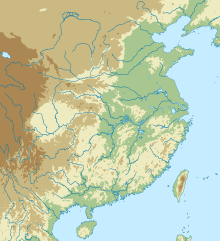| Battle of Sincouwaan | |||||||
|---|---|---|---|---|---|---|---|
| |||||||
| Belligerents | |||||||
| Ming dynasty | Kingdom of Portugal | ||||||
| Commanders and leaders | |||||||
|
Wang Hong (汪鈜), Zhang Ding (張嵿), Ke Rong (柯榮), Wang Ying'en (王應恩) † |
Martim Afonso de Mello Coutinho [pt] Pedro Homem † | ||||||
| Strength | |||||||
|
30 ships [1] |
6 ships | ||||||
| Casualties and losses | |||||||
| Unknown |
1 ship destroyed 1 ship captured 42 men captured[4] | ||||||
Location within Hong Kong | |||||||
The Battle of Sincouwaan[5] (traditional Chinese: 茜草灣之戰; simplified Chinese: 茜草湾之战; pinyin: Qiàncǎo Wān zhī Zhàn), also known as Battle of Veniaga Island (Portuguese: Batalha da Ilha da Veniaga) was a naval battle between the Ming dynasty coast guard and a Portuguese fleet led by Martim Afonso de Mello that occurred in 1522. The Ming court threatened to expel Portuguese traders from China after receiving news that the Malacca Sultanate, a Ming tributary, had been invaded by the Portuguese. In addition, the Portuguese had been conducting piracy, acquiring slaves on the Chinese coast to sell in Portuguese Malacca, and preventing other foreigners from trading in China. Portuguese traders were executed in China and a Portuguese embassy was arrested, with their freedom promised on the condition that the Portuguese returned Malacca to its sultan. Martim Afonso de Mello arrived at the Pearl River but was blockaded by a Ming fleet despite his offers of amends. After two weeks without being able to gain a foothold in China they decided to run the blockade and managed to escape with the loss of two ships and several dozen men. The battle was fought off the northwestern coast of Lantau Island, Hong Kong at a location called Sai Tso Wan today.
- ^ Andrade 2016, p. 128.
- ^ Monteiro 1995, p. 5.
- ^ Hao 2010, p. 12.
- ^ Diffie 1977, p. 385.
- ^ Chinese Character Database: With Word-formations Phonologically Disambiguated According to the Cantonese Dialect 茜 and 扇 carry the same syllable in Cantonese -- sin3; in addition, 草 carries cou2 and 灣 waan1.
© MMXXIII Rich X Search. We shall prevail. All rights reserved. Rich X Search


